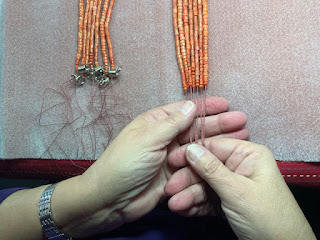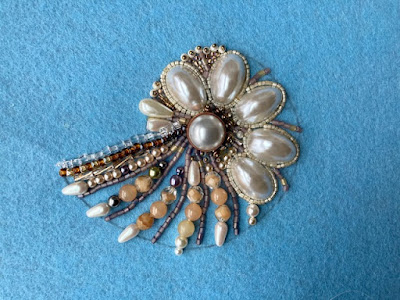It was an honour to create Korali, a multi-strand coral necklace in a traditional Ukrainian-style for a client in Winnipeg. This is the first of four projects.
Red coral was a traditional element of Ukrainian folkwear, extremely highly prized and cherished. It was not only an ornament showing status, but also an amulet of protection, a talisman of health and beauty. Here is an article about Ukrainian neck ornaments.
Coral was brought to Ukraine from the Mediterranean and Red Seas. Its price depended on the color, quality, size and shape of the bead. The most expensive corals were red, smoothly polished, perfectly oval or barrel-shaped. Coral comes in many grades, shapes and sizes and is sold by weight. In Ukraine, coral beads were traditionally strung on thread and from 1 to 25 strands braided into ties for multi-strand ‘korali’ necklace.
Simply put, coral is a “garden of the sea” organic gemstone mostly harvested in the Mediterranean Sea. Calcareous coral ranges from red, pink to orange. It is known to fade with wear and tear. Unhealthy corals show fewer colours, more algal symbionts, more breakage and often are bleached white.
The challenge was in solely working with the materials (coral) provided in several necklaces and a bracelet Natalka acquired over time.
CORAL SOURCES
 |
| Head side of ducat of Franz Josyf |
A prized ducat of Franz Josyf from 1900 was going to be the focal of a single strand of coral. The reverse of this coin is more interesting as a focal today, however Natalka can choose which side to wear in front.
 |
| Reverse of ducat of Franz Josyf |
This coin is called a ‘moneta’ in Ukrainian. Some refer to it as ‘zgarda’, an amulet to protect the wearer. ‘Zgardy’ were traditionally metal Hutsul-style crosses linked with spacers or beads, but in other regions ‘monety’ were also called ‘zgardy.
The large coral
bead with the metal cover (seen in above photo) was going to be front and center of the lower
multi-strand.
 |
| Flower box clasp |
They don’t make
box clasps like this these days! In its previous life this two strand necklace
was a nice accessory to go with contemporary fashion of yesteryear.
 |
| Graduated coral beads and old box clasp |
This three-strand bracelet yielded a lot of graduated coral beads. Again this is an older bracelet because they don’t make box clasps like this today!
 |
| Three strands to two stands to one strand |
This three-strand necklace handled the problem-solving of reducing multiple strings into one string at the back well, but lacked the traditional Ukrainian soul. This definitely begged to be taken apart!
DESIGNING KORALI ON BEADING WIRE
 |
| Vellux-covered dining table |
Once all beads were released on my vellux-covered dining table, I cut 1 meter long beading wire strands to start designing the multi-strand necklace. Picking up beads using the flexible beading wire is easy, as is rearranging their order. Spring coils are essential for keeping the beads on the strings while working. They could be easily removed to reorder the sequence of shapes and sizes.
 |
| Centering larger beads |
A metal 24” ruler helped with the centering of the larger beads. The single metal covered coral was going in the middle of the longest 23” string. The bracelets provided large center beads for three more strands. Each strand would be 1-1/2” shorter than the string before.
 |
| Hard at work |
It was a slow, tedious process as the shapes and sizes really varied.
 |
| Seven strands done |
Slowly I managed to string seven (7) strands which each one decreasing an 1-1/2”. This was important for when I was to drape them into a necklace.
RESTRINGING ONTO THREAD
 |
| Restringing onto thread |
Once the strands were set, I cut #4 beading thread from BeadSmith into 2 yds. long threads for restringing the beads. The math was: 24” length + (6” end + 6” end ) x 2 double = 72”. (In hindsight, I would have cut the threads 3-4 yds. long because braiding the ends gobbles up a lot of threads. (You’ll see what I mean in later photos.)
Thank goodness for The ‘BIG EYE” needle which was easy to thread and thin enough to go through the tiny drilled holes in organic coral beads of all shapes and sizes. I centered the needle and proceeded to slide off the beads from the wire onto my needle and double thread. I added smaller round coral beads to the ends because several strands were going to be tied into one knot.
 |
| Gathering strands |
Very carefully I gathered the strands together and them proceeded to tie them into a circle knot.
 |
| Making a circle knot |
Using a hat pin helps place and tighten the knot. I repeated the same procedure to the other side. This was a nerve-wrecking step!!
 |
| Preparing to braid threads |
Once both sides were secured, I divided the threads into three groupings for braiding.
 |
| Braiding threads |
I started braiding the threads. It was important to maintain the same tension and plait as evenly as possible. Since the braiding process gobbles a lot of thread, my braid was too short to easily tie when Natalka would want to wear the Korali.
 |
| One braid done, but then unbraided |
SOLUTION
 |
| Adding longer thread |
I undid the
original thread braid and introduced a much longer orange thread by tying in
next to the knotted #4 threads.
 |
| Preparing to braid with added longer thread |
Again, I divided the threads into three grouping and start braiding. This time it was more challenging because I was getting whiskers as I was braiding the longer orange threads together with shorter red ones. I trimmed away the short thread whiskers. This was not ideal, but necessary so that longer ties would be easier to tie on the multi-strand Korali.
 |
| Completed seven-strand Korali |
Completed seven- strand Korali necklace is ready to wear.
 |
| Looks great with black turtleneck |
I tied on the Korali to test out the look and feel of them. I am pleased that a collection of random necklaces and bracelet have the look and feel of a traditional coral necklace. The more strands, the better!
THE MONETA — ZGARDA
I’m grateful to my friend Adele Kodonova’s offer to help me while she was visiting from the Czech Republic.
 |
| Adele's workstation |
First of all, I was impressed to see how she works. Adela prefers to bead on a kitchen towel which provides an ideal beading surface. She preferred beading with a needle and thread rather than wire and crimps, especially when the coral beads had such small holes. It was impossible to pass a wire back down coral beads to reinforce.
 |
| Drawing plan for adding seed beads |
Adela’s solution to finishing a necklace of beads with small holes with a needle and thread. Add seed beads at the ends to be able to turn around and secure the thread further from the clasp. Here Adela was sketching out the plan. The coin is still on wire.
 |
| Drawing plan for finish and secure clasp |
When working with thread, secure a folded thread around a clasp with a slip knot. Then start stringing through the seed beads, then the coral beads. Once she got to the center, she paused to figure a solution to make sure the heavy coin laid in line with the coral beads.
 |
| Testing the use of seed beads with the coin |
Adela strung a few seed beads, then slid the coin’s tubular soldered ear onto the coin. Then she tested the necklace to make sure the coin lay properly with the seed beads filling the tube.
 |
| Hanging test |
I’ve learned many tips and tricks from Adela and know the Moneta - Zgarda is well made!
 |
| Using fine thread loop to pull through thicker thread |
Next came completing the string of corals. Then adding the seed beads to balance the necklace, as well as providing a large enough space for the needle and thread to pass back through to knot and secure the thread. Adela had a trick for pulling a thicker thread that cannot be threaded on a fine needle. Creating a loop of fine thread for the heavier thread to pass one bead at a time worked well.
 |
| Completed necklace |
We chose a .925 silver toggle clasp with and M-bar. The detail in the clasp coordinates with the reverse side of the coin. To finish it off, she knotted in between seed beads to reinforce finished the korali string perfectly!
FINAL LIGHTER KORALI STRAND
Since coral is an organic material which fades with wear and tear, I was sorting out lighter whiter beads out of the mix from all the coral beads I was restringing into the multi-strand Korali and Moneta necklaces.
I believe the lighter corals are still valuable because they are natural. I wanted to return them to Natalka in form of a strung necklace. Again, Adela strung it on thread. To make it easy to put it on, she created a little dangle of coral on a head pin. She attached it to the closed jump ring for an easy find and ability to dress herself.
 |
Little dangle of
coral by the clasp |
I am grateful for
Adela’s help to finish off smaller necklaces.
This has been a wonderful challenge and a hands-on opportunity to work with coral in different shapes and sizes. I now have a whole new respect when I see vintage coral for sale. I note how they are shaped, their color and sizes. I pay attention to how korali are strung. Thank you, Natalka!
























